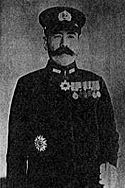- Masatomi Kimura
-
Masatomi Kimura 
Admiral Masatomi KimuraBorn December 6, 1891
Shizuoka, JapanDied February 14, 1960 (aged 68)[1]
Hofu, Yamaguchi JapanAllegiance Empire of Japan Service/branch  Imperial Japanese Navy
Imperial Japanese NavyYears of service 1913-1945 Rank Vice Admiral Commands held World War II
oBattle of the Bismarck Sea
oEvacuation of Kiska
oBattle of Leyte GulfOther work Anti-Submarine Warfare School
Hofu Naval Communications SchoolIn this Japanese name, the family name is "Kimura".Masatomi Kimura (木村 昌福 Kimura Masatomi, December 6, 1891 – February 14, 1960), was an admiral in the Imperial Japanese Navy during World War II.
Contents
Biography
Although born into the Kondō family of Shizuoka city Shizuoka Prefecture, Kimura was adopted by a family in Tottori city, Tottori prefecture soon after birth, and considered Tottori his official residence. He was a graduate of the 41st class of the Imperial Japanese Naval Academy, and placed 107 out of 118 cadets, so his academic background could not be said to have been outstanding.
Kimura served his Midshipman duty on the Asama, making a cruise to Honolulu and to the west coast of the United States. He transferred to Yakumo on his return in 1914. After he was commissioned as an Ensign, he was assigned to the battleship Sagami and Suwo. After completing required coursework in torpedo warfare and naval artillery, he was posted to the South Pacific in the closing stages of World War I. On his return to Japan in 1918, he was posted to the Mikasa.
After his promotion to Lieutenant in 1920, he commanded numerous torpedo boats and minesweepers. In 1926, after he was promoted to Lieutenant Commander, he was given command of the destroyer seaplane tender Kagu-maru, auxiliary oiler Shiretoko, cruiser Jintsu and Suzuya.
He was captain of Suzuya during the attack on Pearl Harbor. He later assisted in the rescue of the crew of the Mikuma after that cruiser had been hit and sunk by American bombers during the Battle of Midway. On 1 November 1942, Kimura was promoted to Rear Admiral. He subsequently served in a number of staff positions, and was also commander of Desron3, with Shirayuki, Shikinami, Uranami, Tokitsukaze, Yukikaze, Asashio, Arashio, and Asagumo. He was assigned to escort seven transports with 6000 soldiers of the IJA 51st division and 400 marines from Rabaul to Lae, New Guinea. In the Battle of the Bismarck Sea on 2 March 1943, US Navy and RAAF bombers inflicted severe damage on the Japanese convoy, sinking most of the transport, four destroyers. Admiral Kimura was wounded by machine gun fire in the shoulder and stomach, and his flagship, Shirayuki, was among the four destroyers sunk during the engagement. He, and most of his crew, are rescued by Shikinami.
After recovering from his injuries, Kimura was assigned to cover the withdrawal of Japanese troops from Kiska Island in the Aleutians. When poor weather threatened the withdrawal operations, Kimura disobeyed orders and remained on station until the last man was recovered. Afterwards, in 1944, he was assigned to escort reinforcements to Leyte Island and Mindoro Island in the Philippines.
On 1 April 1945, Kimura became commandant of the Anti-submarine Warfare School, and the Hofu Naval Communications School. He was promoted to Vice Admiral on 1 November 1945, a few days before he entered the reserves.
Kimura died of stomach cancer in 1960.
References
Books
- Arbon, J (1979). The Bismarck Sea ran red. Walsworth Press. ASIN B0006XMVUI.
- Dupuy, Trevor (1994). The Encyclopedia of Military Biography. I B Tauris & Co Ltd. ISBN 1-850-43569-3.
- Birdsall, Steve (1977). Flying buccaneers: The illustrated story of Kenney's Fifth Air Force. Doubleday. ISBN 0-385-03218-8.
- Bruning, John R., Jr. (2005). "Chapter Seven – The Butchers of Bismarck Sea". Ship Strike Pacific. St. Paul, Minnesota, USA: Zenith Press. ISBN 0-7603-2095-0.
- Henebry, John P. (2002). The Grim Reapers at Work in the Pacific Theater: The Third Attack Group of the U.S. Fifth Air Force. Pictorial Histories Publishing Company. ISBN 1-57510-093-2.
- McAulay, Lex (1991). Battle of the Bismarck Sea. St Martins Pr; 1st ed edition. ISBN 0-312-05820-9.
- Morison, Samuel Eliot (1958). Breaking the Bismarcks Barrier, vol. 6 of History of United States Naval Operations in World War II. Castle Books. 0785813071.
External links
- Brad Manera,(Military Historian, Australian War Memorial, 2003, Battle of the Bismarck Sea, 2-4 March 1943
- Historic Wings: Battle of the Bismarck Sea
- Dr Alan Stephens, ?, "Battle of the Bismarck Sea"
- Geoff Hastwell, 2003, "The Battle of the Bismarck Sea"
- Allyn D. Nevitt, 1996, "Battle of the Bismarck Sea"
- Craven, Wesley Frank; James Lea Cate. "Vol. IV, The Pacific: Guadalcanal to Saipan, August 1942 to July 1944". The Army Air Forces in World War II. U.S. Office of Air Force History. http://www.ibiblio.org/hyperwar/AAF/IV/index.html. Retrieved October 20, 2006.
- Nishida, Hiroshi. "Imperial Japanese Navy". http://homepage2.nifty.com/nishidah/e/px41.htm#v010. Retrieved 2007-02-25.
Notes
- ^ Nishida, Imperial Japanese Navy.
 Categories:
Categories:- 1891 births
- 1960 deaths
- People from Shizuoka (city)
- People from Tottori Prefecture
- Japanese military personnel of World War II
- Imperial Japanese Navy admirals
- Deaths from stomach cancer
- Cancer deaths in Japan
Wikimedia Foundation. 2010.
